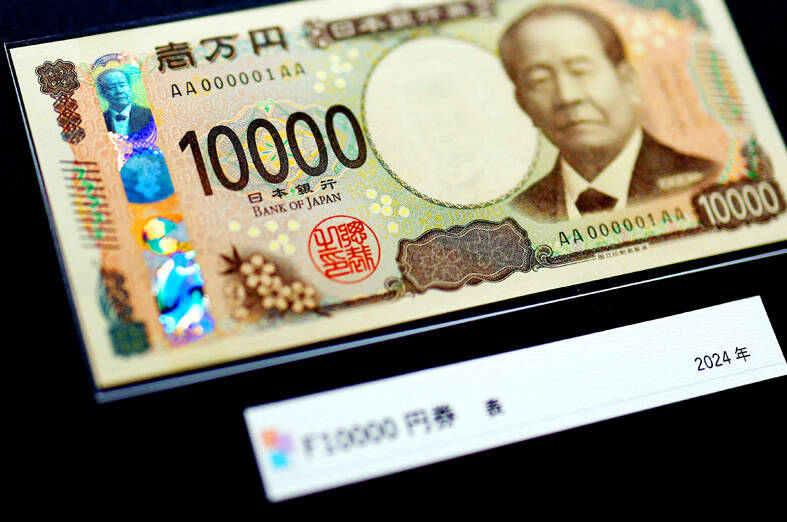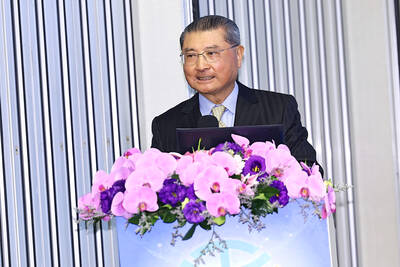Japan ramped up its warnings against currency speculation on Friday after the yen slid to a five-month low following a hint from the central bank chief that he might wait longer than expected before raising interest rates.
“The government’s deeply concerned about recent currency moves, including those driven by speculators,” Japanese Minister of Finance Katsunobu Kato said. “We will take appropriate action if there are excessive moves in the currency market.”
The yen regained some ground against the dollar after Kato’s remarks, strengthening to as much as ¥156.89 after earlier weakening to ¥157.93. The Japanese currency strengthened a little further after currency chief Atsushi Mimura also backed up Kato with similar comments in the afternoon.

Photo: Reuters
“We’re deeply concerned about recent foreign exchange moves,” Mimura told reporters. “For now I think it’s best not to say more beyond saying we’ll take appropriate responses against any excessive moves.”
The senior Japanese officials’ comments come as recent sharp movements in the yen feed into concerns that the Japanese government might intervene in the currency market to support its currency.
Authorities have stayed out of the market since July, when the yen hit ¥160 against the US dollar, partly driven by speculators capitalizing on the wide interest rate gap between Japan and the US. Tokyo has spent close to US$100 billion propping up the yen so far this year.
With the holiday season approaching, liquidity in the market is expected to decline, raising the possibility of more abrupt moves in the currency. Low liquidity also presents policymakers in Japan with a potential opportunity to have a relatively larger impact on the currency level if they do step into the market.
The yen experienced a sharp slide on Thursday following Bank of Japan (BOJ) Governor Kazuo Ueda’s comments hinting at the possibility of waiting longer before its next rate hike.
The central bank kept rates unchanged at the end of its meeting on Thursday, as expected by just over half of the economists surveyed by Bloomberg. Most respondents had projected the next rate hike to come by January.
Currency chief Mimura refrained from commenting on the BOJ’s recent communication, saying he should respect the central bank’s independence.
Overnight revisions to US GDP data and the US Federal Reserve’s preferred inflation gauges put further pressure on the yen, as it strengthened the market’s view that the Fed might slow its easing measures further. This followed a reduction in the number of the Fed’s expected rate cuts next year.
Separately, Japan’s key inflation gauge strengthened on the waning impact of government energy subsidies as the central bank continues to parse data before deciding on the timing of its next interest rate hike.
Consumer prices excluding fresh food rose 2.7 percent in November from a year earlier, driven by higher energy costs, the Ministry of Internal Affairs reported on Friday. That came in above a consensus estimate of 2.6 percent, and was higher than October’s 2.3 percent increase. An index excluding energy costs and fresh food prices advanced 2.4 percent, up from 2.3 percent.
Friday’s data support the view among economists that inflation continues to develop in line with the BOJ’s outlook, and the bank would likely keep reducing the degree of its monetary easing with gradual interest rate hikes.

When an apartment comes up for rent in Germany’s big cities, hundreds of prospective tenants often queue down the street to view it, but the acute shortage of affordable housing is getting scant attention ahead of today’s snap general election. “Housing is one of the main problems for people, but nobody talks about it, nobody takes it seriously,” said Andreas Ibel, president of Build Europe, an association representing housing developers. Migration and the sluggish economy top the list of voters’ concerns, but analysts say housing policy fails to break through as returns on investment take time to register, making the

‘SILVER LINING’: Although the news caused TSMC to fall on the local market, an analyst said that as tariffs are not set to go into effect until April, there is still time for negotiations US President Donald Trump on Tuesday said that he would likely impose tariffs on semiconductor, automobile and pharmaceutical imports of about 25 percent, with an announcement coming as soon as April 2 in a move that would represent a dramatic widening of the US leader’s trade war. “I probably will tell you that on April 2, but it’ll be in the neighborhood of 25 percent,” Trump told reporters at his Mar-a-Lago club when asked about his plan for auto tariffs. Asked about similar levies on pharmaceutical drugs and semiconductors, the president said that “it’ll be 25 percent and higher, and it’ll

CHIP BOOM: Revenue for the semiconductor industry is set to reach US$1 trillion by 2032, opening up opportunities for the chip pacakging and testing company, it said ASE Technology Holding Co (日月光投控), the world’s largest provider of outsourced semiconductor assembly and test (OSAT) services, yesterday launched a new advanced manufacturing facility in Penang, Malaysia, aiming to meet growing demand for emerging technologies such as generative artificial intelligence (AI) applications. The US$300 million facility is a critical step in expanding ASE’s global footprint, offering an alternative for customers from the US, Europe, Japan, South Korea and China to assemble and test chips outside of Taiwan amid efforts to diversify supply chains. The plant, the company’s fifth in Malaysia, is part of a strategic expansion plan that would more than triple

Taiwanese artificial intelligence (AI) server makers are expected to make major investments in Texas in May after US President Donald Trump’s first 100 days in office and amid his rising tariff threats, Taiwan Electrical and Electronic Manufacturers’ Association (TEEMA, 台灣電子電機公會) chairman Richard Lee (李詩欽) said yesterday. The association led a delegation of seven AI server manufacturers to Washington, as well as the US states of California, Texas and New Mexico, to discuss land and tax issues, as Taiwanese firms speed up their production plans in the US with many of them seeing Texas as their top option for investment, Lee said. The